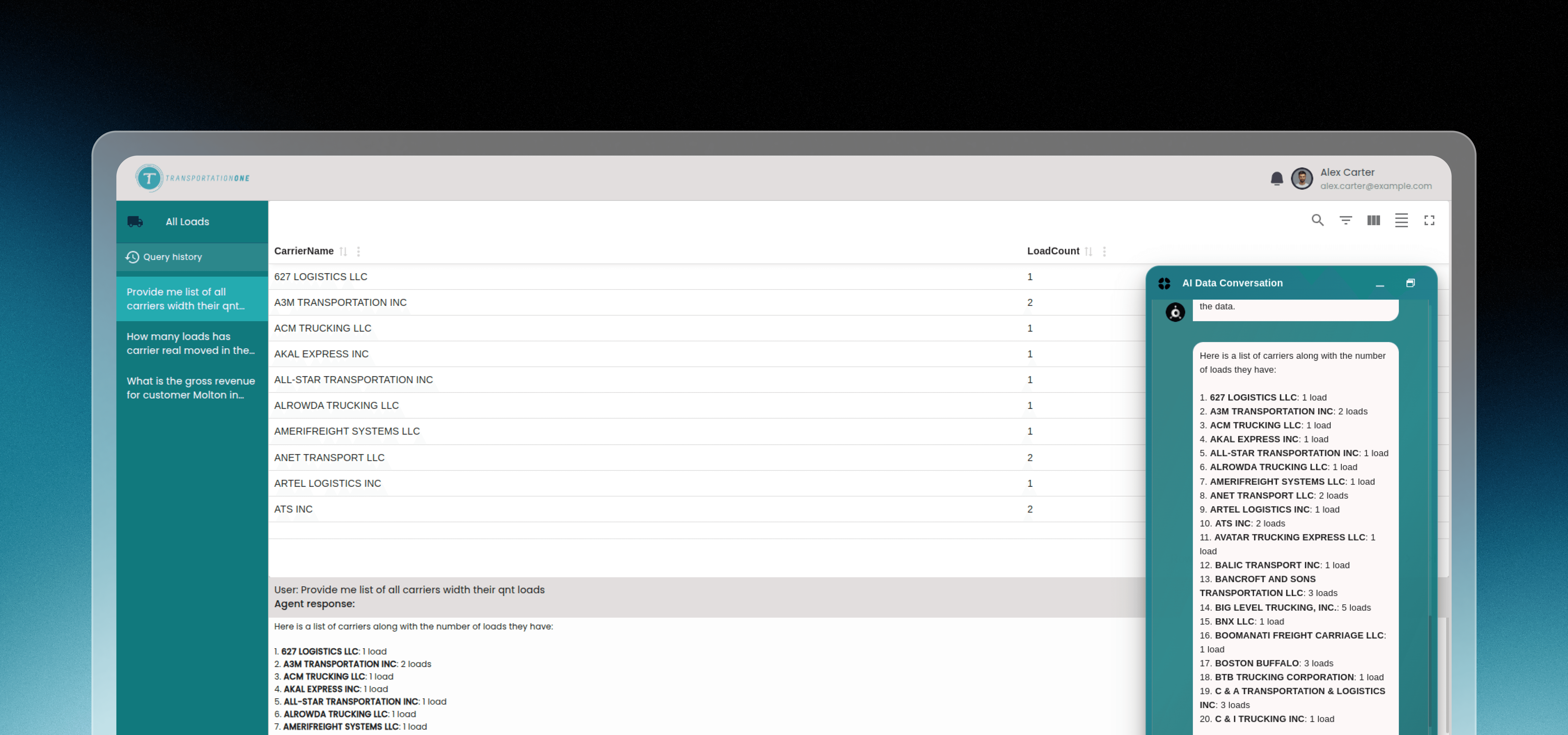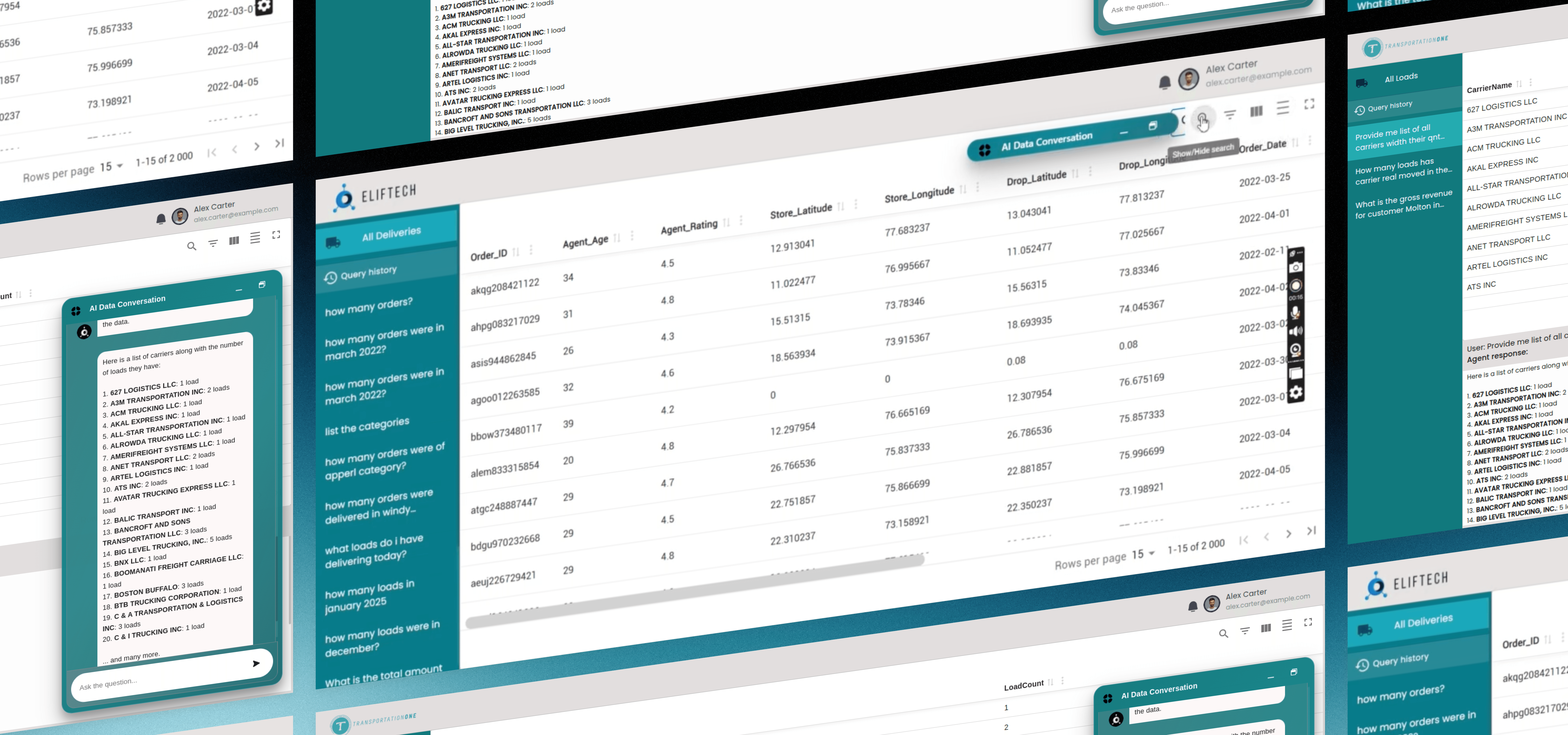- Conversational AI & NL2SQL
- MVP Development
- Architecture & Infrastructure Design
- Backend Engineering
- Data Engineering & Integrations
- Web App & Dashboard Development
- REST API Integration
- QA & Test Automation
- DevOps & CI/CD
- Security & Compliance
AI SQL chatbot
Natural-language access to freight data for sales & ops
We built a production-ready chatbot that turns plain-English questions into safe SQL, fetches answers from internal freight databases in real time, and returns results in a clean UI. Validation layers prevent bad queries, while a modular toolset lets the agent understand schemas, check syntax, and execute only approved reads. The system scales across tables and schemas as the business grows.
Industry
AI
Headquarters
 USA
USA

Services we provided
About the Client
Carrier sales teams and managers required fast, self-serve access to operational and financial data, load statuses, customer revenue, aging balances, and other key information. Requests are routinely queued behind technical staff, which slows down decisions and customer support.
Challenge
Data lived in internal databases that only technical teams could query. Sales and ops relied on manual handoffs and ad-hoc extracts, creating delays, copy/paste errors, and inconsistent answers to customers. The client required a secure and auditable method for non-technical users to ask questions in natural language and receive accurate results, without granting write access or risking schema-breaking queries.

Solution
-
Natural-language-to-SQL agent
Converts user questions into read-only SQL and routes execution safely.
-
Schema understanding tools
Introspection utilities fetch database and table structures, data types, and relationships. The agent caches this metadata, tracks schema versions, and adapts queries when fields are renamed or added.
-
Query validation
A pre-execution gate checks syntax and semantics, applies an allowlist/denylist of statements, enforces row limits and timeouts, estimates query “cost,” and blocks anything unsafe or wasteful before it hits production.
-
Execution & result delivery
Approved queries run against live internal DBs. Large result sets are paginated and summarized in chat, with full tables rendered in the UI for drill-down, CSV export, and copy-safe formatting. Numbers and dates are normalized to business units and time zones.
-
Context search for entities
Vector search, along with synonym dictionaries, normalizes fuzzy inputs (e.g., customer nicknames, lane aliases). The agent resolves them to canonical IDs to maintain consistent answers across teams.
-
Scalable architecture
Modular toolchain (LangGraph) and observability (LangSmith) support the addition of new tables/schemas without requiring rework.
-
Governance & safety
Read-only credentials, no DML, RBAC for sensitive tables, and automatic PII redaction in responses. Every valid request/response is logged for audit, model improvement, and coaching.
Features delivered
-
Natural language to SQL query engine
Ask in everyday language and receive accurate SQL and human-readable answers, with the generated query displayed for transparency when needed.
-
Real-time internal data access
Answers are pulled directly from operational databases, ensuring that decisions are based on current load, customer, and revenue data.
-
Error prevention via query validation
Syntax/semantic guards, row caps, and safety policies prevent harmful or risky queries from being executed, thereby reducing token usage and database load.
-
Multi-DB & evolving schemas
Adapters support multiple databases and schema changes. The agent detects new fields, updates its metadata, and adjusts queries with minimal configuration.
-
Scalable, enterprise-ready design
Stateless services, centralized observability, RBAC, and environment-based configuration make it straightforward to deploy, monitor, and govern at scale.
Key results and business value
-
Up to 80% faster data retrieval
Self-serve access removed analyst queues for routine questions, cutting wait times from hours to minutes or to seconds for common lookups.
-
60% fewer query errors
Validation layers and entity normalization eliminated malformed or mis-scoped requests, reducing rework and back-and-forth.
-
Faster customer responses
Sales reps answered load status and revenue questions during the call, improving win rates and customer satisfaction.
-
Lower support load on technical teams
Ad-hoc report and export requests dropped significantly, freeing engineers and analysts to focus on higher-value projects.
-
Consistent, auditable answers
Logged prompts, SQL, and outputs provide traceability for compliance and training, and create a searchable knowledge trail of “what we asked and what we got.”
-
Future-proof access layer
Architecture adapts to new tables, data types, and business growth.